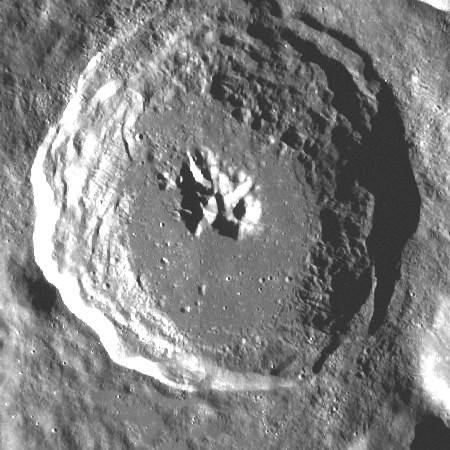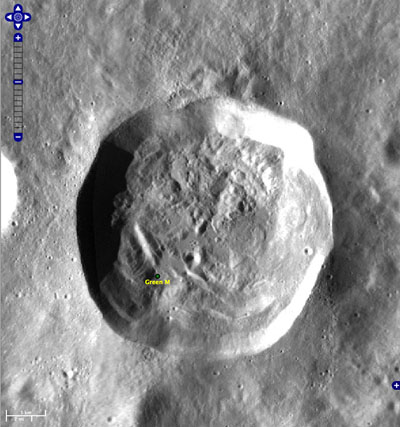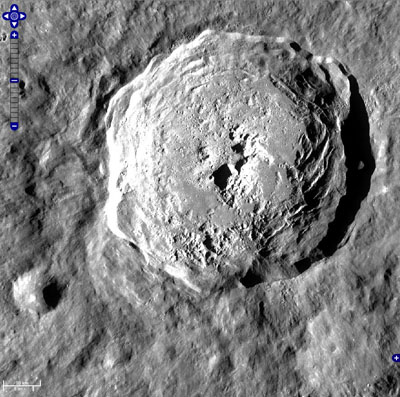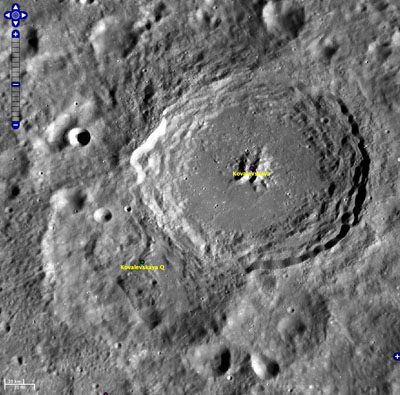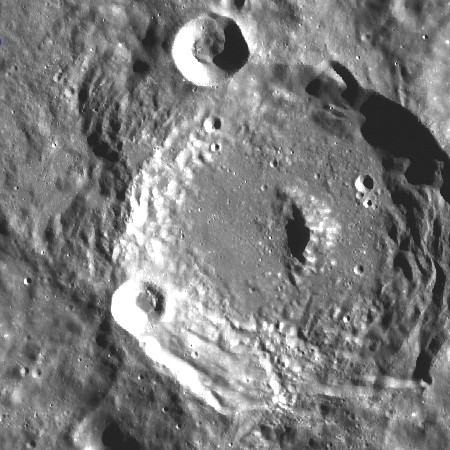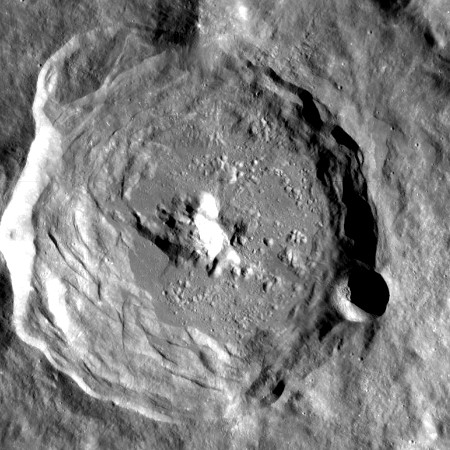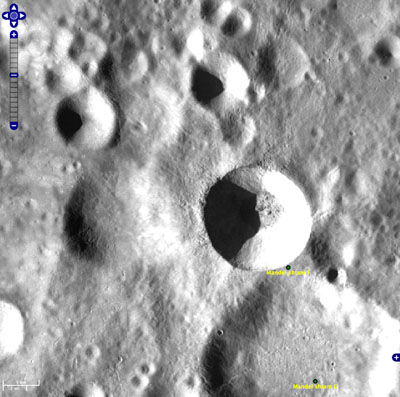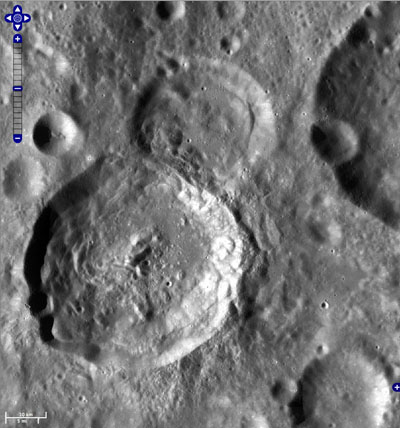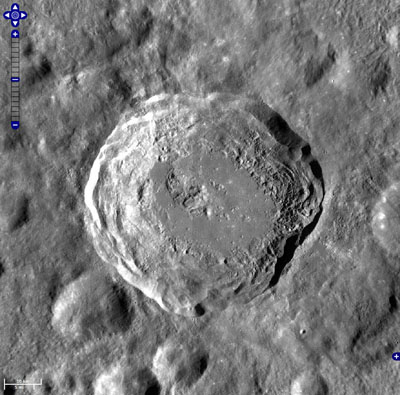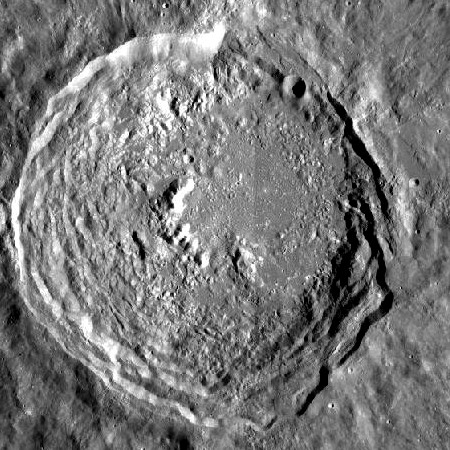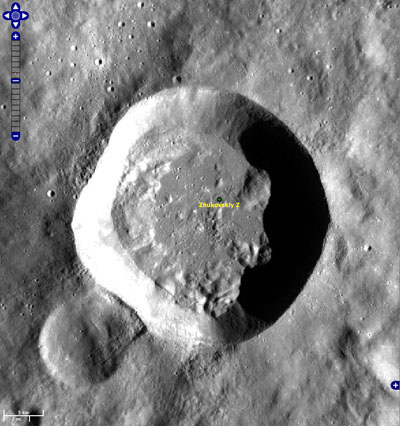Impact Melt Craters
Surely there are many more farside impact melt waiting to be discovered! Newly discovered impact melt craters can be added to this list, ideally, with LRO images showing the deposits.
| . PLZ : melt covers S sectors of floor and there are isolated melt patches beyond the S rim. |
Green M
| HH: Exterior impact melt deposits on a 35 km diameter crater S of Green, with most extensive deposits to NNW, max of ~1 km beyond rim. CAW: Crater now known as Green M at 0.33°N, 133.12°E with diameter of 32 km. Melt patches near center of floor but none visible on rim or beyond. |
Jackson
|
CAW: 72 km wide Jackson is one of the most conspicuous craters in the high Sun Clementine imagerybecause of its bright and extensive ray system. Melt occurs around the S, E and NE parts of Jackson's floor and as small ponds in low spots on the floor of an old crater that Jackson overlaps more than 50% to its SW; a few other ponds are just outside the rim to the WNW. The peculiar thing is that Jackson's rays have a pronounced zone of avoidance showing that Jackson was formed by an oblique impact and the projectile came from the NW, but there are only very tiny downrange melt ponds to the SE. In this case the low rim on the SW seems to have determined the location of melt outside the rim. Clementine also reveals a dark collar of impact melt, similar to those of Tycho and Ohm - all must be very young craters. The impact melt on the floor of Jackson was recognized on a Kaguya image. |
King
HH: Exterior impact melt deposits most extensive to NE, max of ~30 km beyond rim. Most extensive ejecta, rays and secondary craters to the NNW, with max wall slumping on SSE side of crater, and topographically lowest rim crest to S & NE. Biggest impact melt pond on Moon.
Kovalevskaya
| CAW: This large (d = 115 km) fresh crater has melt predominantly on the SSE side of its floor. Its rim in that direction is low because of overlapping the pre-existing Kovalevskaya Q and melt fills low spots in Q. |
| . PLZ : melt covers W sector of floor and there are melt ponds past the W rim, covering slumped walls towards Chebyshev crater. |
| . PLZ : melts cover sectors of W and E floor and there are isolated melt ponds following the NE rim |
Mandel'shtam F
| CAW: A 15 km wide simple crater with melt and debris filled floor. Thin melt ponds on floor of subdued crater beyond rim about 13 to W. |
Mandel'shtam R
| HH: Exterior impact melt deposits on Mandel'shtam R are most extensive to NNE, max of ~22 km beyond rim, with max wall slumping on SW side of crater, and topographically lowest rim crest to N. CAW: Non-fresh melts on NNE side of crater floor, in overlapped crater to NNE and in ponds to the E. |
Maunder
HH: Exterior impact melt deposits most extensive to NNW, max of ~30 km beyond rim. Most extensive ejecta, rays and secondary craters to the NE, with max wall slumping on NNW side of crater, and topographically lowest rim crest to NNW.
Necho
HH: Exterior impact melt deposits most extensive to NE, max of ~12 km beyond rim, and topographically lowest rim crest to NE.
O'Day
HH: Exterior impact melt deposits most extensive to ESE, max of ~30 km beyond rim. Most extensive ejecta, rays and secondary craters to the SE, with max wall slumping on W side of crater, and topographically lowest rim crest to SE.
Ohm
| CAW: Very fresh, bright rayed crater (D = 64 km) with abundant melt on floor and small ponds just a km or so east of rim crest. |
Schrödinger
HH: Exterior impact melt deposits to E, max of ~100 km beyond rim. Most extensive ejecta, rays and secondary craters to the NE, with max wall slumping on E side of crater, and topographically lowest rim crest to S.
Sharonov
HH: Exterior impact melt.
Stearns
HH: Exterior impact melt deposits most extensive to NNE, max of ~25 km beyond rim. Max wall slumping on N side of crater, and topographically lowest rim crest to SE
Tsiolkovskiy
HH: Exterior impact melt deposits most extensive to SE, max of ~50 km beyond rim. Most extensive ejecta, rays and secondary craters to the SSE, with max wall slumping on SE side of crater, and topographically lowest rim crest to W.
| . PLZ : melts cover the E floor and terraces of Vavilov and, beyond the NE rim, low spots of preexisting satellite Vavilov D. |
Von Neumann
HH: Exterior impact melt deposits most extensive to NE, max of ~6 km beyond rim. Max wall slumping on SW side of crater, and topographically lowest rim crest to NE.
Wiener F
HH: Exterior impact melt deposits on Wiener F, with most extensive deposits to N, max of ~13 km beyond rim, and topographically lowest rim crest to N. This is one of the most spectacular impact melt on the Moon, with a melt flow on the outer slope of F ponding on the floor of the unnamed crater to the north.
Zhukovskiy Z
| HH: Exterior impact melt deposits on a 32 km diameter crater N of Zhukovskiy (Zhukovskiy Z?), with most extensive deposits to W. CAW: Zhukovskiy Z is the crater but there are no obvious melts outside the crater and if the material on the floor is melt it has lost its original morphology. |
